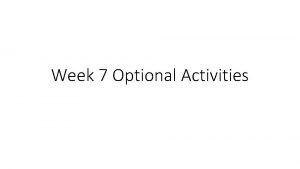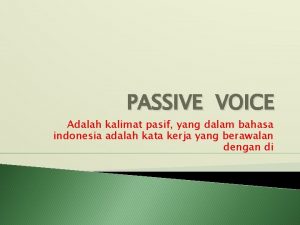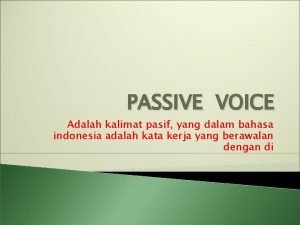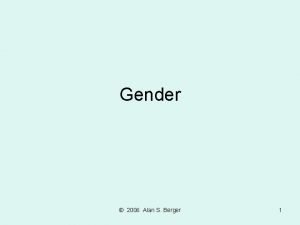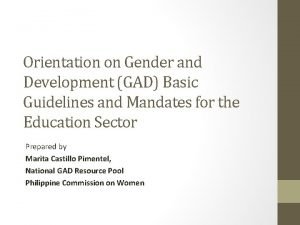The Plan This week Gender Next Week Social



























































- Slides: 59

The Plan: This week – Gender Next Week – Social Groups EASTER HOLIDAYS! Week 1 – Occupation Week 2 – Regional Variation Paper 2 At least one for each area Q 1/2 Q 3 Q 4 You will be doing a lot of practice! Embrace it! Exam Dates: 20 th May P 1 4 th June P 2

Gender – What do I need to know? Examiners do not look favourably if you are getting you concepts and theories mixed up!

Do you have these gender booklets? These have EVERYTHING you need to know in them!

A deficit model is the idea that some types of language are lesser. In terms of gender this suggests that male speech is the standard. If we think about accents, a deficit model would consider the standard of RP. A dominance model is to do with power! Because men are more powerful in society obviously their language is more powerful. Again, this can also be considered in other areas. A difference model, suggests that language is just used differently because of different aims (however these models still tend to perpetuate stereotypes!). Think ”Men are from Mars, Women are from Venus” Diversity – language isn’t just about gender at all!! We have to consider many other factors too! This almost directly challenges all of the other models…. takes them all out! In a bit more detail……

THE BIG 3! • You must be able to discuss the different models. • You must also know these theorists – as a minimum!

Robin Lakoff • The Deficit Model Robin Lakoff 1975 describes male language as stronger, more prestigious and more desirable. • She published a set of basic assumptions about what marks out the language of women. Among these are: You MUST be able to identify some of these and refer to them! They may pop up in data! This is how you get your terminology in!

• • • • • Hedge: using phrases like “sort of”, “kind of”, “it seems like”, and so on. Use (super)polite forms: “Would you mind. . . ”, “I'd appreciate it if. . . ”, “. . . if you don't mind”. Use tag questions: “You're going to dinner, aren't you? ” Speak in italics: intonational emphasis equal to underlining words - so, very, quite. Use empty adjectives: divine, lovely, adorable, and so on Use hypercorrect grammar and pronunciation: English prestige grammar and clear enunciation. Use direct quotation: men paraphrase more often. Have a special lexicon: women use more words for things like colours, men for sports. Use question intonation in declarative statements: women make declarative statements into questions by raising the pitch of their voice at the end of a statement, expressing uncertainty. For example, “What school do you attend? Eton College? ” Use “wh-” imperatives: (such as, “Why don't you open the door? ”) Speak less frequently Overuse qualifiers: (for example, “I Think that. . . ”) Apologise more: (for instance, “I'm sorry, but I think that. . . ”) Use modal constructions: (such as can, would, should, ought - “Should we turn up the heat? ”) Avoid coarse language or expletives Use indirect commands and requests: (for example, “My, isn't it cold in here? ” - really a request to turn the heat on or close a window) Use more intensifiers: especially so and very (for instance, “I am so glad you came!”) Lack a sense of humour: women do not tell jokes well and often don't understand the punch line of jokes.

Problems? • Dated • Lakoff’s description of women’s language style was completely based on her own insight, her remembered impressions rather than on any systematic quantitative observation.

Deborah Tannen (1990) – DIFFERENCE! You Just Don’t Understand: Men and Women in Conversation • Controversial – looked at mixed-gender conversation. • She attempts to explain “male-female miscommunication” by claiming that male-female speech is “cross-cultural communication”.

In a nut shell…men and women use language differently! A bit like this bestseller!

Status vs. Support. Men see conversation as a contest, women do not think of the people they converse with as ‘trying to get one up on them’. Independence vs. Intimacy. Men see consulting with their partner to be ‘asking for permission’ rather than simply discussing. E. G Evidence of interruption? Advice vs. Understanding. To many men a complaint is a challenge to come up with a solution, but often women are looking for emotional support, not solutions. E. G The use of a mitigated imperative in ”Let’s shut the door” “Why don’t you cook dinner? ” Information vs. Feelings. To men, talk is information. It has a practical purpose, and if it does not…it’s just not worth saying! Look for abstract nouns, adjectives – “extra words” Orders vs. Proposals Women hedge their orders, “Let’s…”. Men can feel that by doing this, a woman is trying to slyly manipulate him to do something rather than just directly ask, like he would. Conflict vs. Compromise. Women are reluctant to openly oppose others When referencing this theory, you will need to refer to specific linguistic examples – the data will help!. You Paper 1 terminology will also help

Overlaps and Tannen • Cooperative Overlap: Interrupting to show support • Competitive Overlap: Interrupting to gain control • High-involvement: show enthusiastic support (even overlapping) • High-consideration: do not impose on the speakers • But Tannen didn’t necessarily think that women needed to change. She challenges the idea that men’s language should be considered the norm.

What could be problematic about these types of models? • Perpetuate stereotypes • Binary opposition – men v’s women attitude rather simplistic? • Does not take into consideration the wider discourses! • Any others? A bit like this bestseller!

Deborah Cameron -- Diversity • Believes that difference is a myth and summarises difference theorists (the following is what they think, not what Cameron thinks): • Language and communication matter more to women • Women are more verbally skilled than men • Women talk about feelings and people; men talk about things and facts • Men are competitive in language, women are cooperative • These differences lead to miscommunication between genders Good one to use to challenge other theories!!!

Deborah Cameron – Differences are not simply binary and gendered… • Any differences are due to societal expectations of each gender. The way men and women think they are meant to speak is “verbal hygiene” – how we use language to impose order in society. • E. G “Sex-worker” not prostitute.


Theory Task – All about the INTERPLAY Evaluation is key!

Theory Task - All about the INTERPLAY Evaluation is key!

Language and Representation • One of Deborah Tannen's most influential ideas is that of the male as norm. Such terms as “men”, “man” and “mankind” may imply this. The term for the species or people in general is the same as that for one sex only.

Key Theorist – Schulz (1975) “Again and again in the history of the language, one finds that a perfectly innocent term designating a girl or woman may begin with totally neutral or even positive connotations, but that gradually it acquires negative implications…after a period of time becoming abusive and ending as a sexual slur. ” https: //aggslanguage. wordpress. com/2010/12/05/top-bandao 2/ Have you visited this yet?

Dale Spender 1980 • Idea is that men dominate women in language, reflecting a patriarchal society "The crux of our difficulties lies in being able to identify and transform the rules which govern our behaviour and which bring patriarchal order into existence. Yet the tools we have for doing this are part of that patriarchal order. While we can modify, we must none the less use the only language, the only classification scheme which is at our disposal. We must use it in a way that is acceptable and meaningful. But that very language and the conditions for its use in turn structure a patriarchal order. "

Semantic Derogation The process in which a word comes to have a negative meaning over time Offer me a definition and example for each of these terms. Collocation refers to words that often go together or that are likely to occur together. For example “eligible bachelor” “pay attention” “happily married” “bright colours” Marked Terms designate a contrasting pair, one possessing a special 'mark', the other neutral: in play/played, play is unmarked and neutral, and played has the mark -ed. Host/Hostess Lexical asymmetry Where a word should mean the same for the genders but actually has different connotations eg bachelor/spinster, cook/chef. Terms!

Gendered SEMANTIC DEROGATION…. • 1362 - ‘Spinster’ referred to a women that spun yarn. • 1402 – ‘Slut’ a women who is untidy and has a dirty appearance. Interestingly it can be argued that ‘Slut’ is one of those words that is being reclaimed in act of resistance. (Attwood 2007) There is no term that refers to men in the same way. Perhaps ’stud’? But that celebrates, rather than berates, sexual promiscuity.

Inequality at the Lexical Level What does each pair of words refer to? Does each of them refer to exactly the same thing? Bachelor / Spinster Master / Madam Waiter / Waitress Host / Hostess Denotation v’s Connotation! It becomes problematic when we begin to investigate how they are used.

Although the words are technically equivalents HOW they are used creates lexical asymmetry. Usually the meaning takes on a negative stance when relating to women.

Gendered collocations • Can you think of any examples that change the meanings behind the words… Lonely old Eligible Pad Of his own destiny Bachelor / Spinster Master / Madam Waiter / Waitress Host / Hostess Little

Why do marked terms matter when it comes to gender? • A term is marked when it has a relationship to a seemingly ‘neutral’ and generic counterpart. • Actor is unmarked and refers to both make and female actors. Actress, the marked term can only be applied to women. It suggests a reliance on, or women as an other to men. • It would not be so problematic if not for the lexical asymmetry. For example master/mistress what are the connotations here?

LET’S PLAY…. . Miss, Mrs, Ms or Mr!

Should it even matter anymore? Female Miss Mr Mrs Ms Asked on a weekly basis. Most forms from loyalty cards to medical questionnaires ask for your title. For women this indicates marital status, but this is not the case for men. Miss = Unmarried Mrs = Married Ms = ? ? ? ? Schwarz (2003) investigates this range of meanings. She identifies the importance society places on marriage for women – similarly to other words too! Men don’t have to make this choice!

It’s not just WHAT you are saying, but HOW you are saying it!! Syntax can be sexist too!!!

Sexism and word order… A diachronic view In 1553 the grammarian Wilson ruled that the man should precede the woman in pairs such as: male/female; husband/wife; brother/sister; son/daughter. 1646 another grammarian Joshua Poole ruled that the male should precede the female. This was both more “natural”, and more “proper” as men were the “worthier” sex.

A recent study would suggest not much has changed… • Heidi Motschenbacher (2013) examined the ordering when both a male and a female are mentioned in a noun phrase. • While one often hears “ladies and gentlemen”, this ordering is unusual. • Far more common for the male noun to be placed first; as in ‘man and wife’. • Have a look at the data handout – any surprises?

How to approach questions…. . • Always be a key concept • Always steering towards the key ideas • Make sure you find that first Evaluate the idea that the language used by men and women always contains miscommunications.

What am I marked on?


Let’s Look at an Example • Introduction to set up argument - answers the question in simplest form • How have they structured the response? Look at the topic statements what do they do? • How have they incorporated examples? • How have they referenced and challenged theories? Got that interplay in! • Language used? Fancy vocabulary?

Planning Questions • Evaluate the idea that women still use speech which implies they are less powerful than men. • Evaluate the idea that there is a bias against women in the English language. • Evaluate the idea that the language used by men and women always contains miscommunications. • Evaluate the idea that “It’s not just that men and women use language in different ways: they actually see it as serving different functions”.

Been Having a Think…. . • I think I have come up with THE BEST and MOST EFFECTIVE essay plan/approach? • BOO YA!

INTRO answer question. Engage with concept. Set up argument ARGUMENT/STATEMENT • One argument is…. . Another argument is……The second reason why…. . • X proposes that…. . • For example……Use examples to explain how theory answers the question (AS - REFER TO DATA) COUNTER ARGUE • However …… • In contrast…. • Alternatively…. X 3 Sections • Despite this…. . EVALUATE • Further more • It is important to acknowledge…. . CONCLUDE • Refer back to the question • Pose another question? • Conclude you findings Essay Plan

Question: CHANGED THIS!!! Topic Statement – linked to key concepts Example/Key Words EXPLAIN How this links to your main idea? Link to theory Who? Key words Challenge/Enforce? EXPLAIN. Why this theory? Who? Key words EXPLAIN. Why this theory?

Question: Topic Statement – linked to key concepts New and Improved Link to theory Who? Explain theory. What they found how links to idea. Examples Challenge/Enforce? Who? Key words Evaluate EXPLAIN. Why this theory?

Topic Statement based on question or Key concept. This could be an agree/disagree statement or a big idea. Link to text Discuss how your idea can been seen in the text. Use specific examples from the text – how do they create meaning? Create representations? Appeal to the audience? Subject specific terminology Include theory Do they agree/disagree? HOW does this theory support your original point/answer the question? EXPLAIN! Evaluate.

Discuss the idea that men’s language is intrinsically more dominant and powerful than women’s. . • Language is the product of culture and ideology; therefore it is always constructed and dominated by those in power. Historically, a patriarchal society has been the norm and inevitably a driving force behind language development and use. However, it would be simplistic to reduce the study of language to simple gender differences – power is intrinsically linked to many aspects of culture and society. This is a super genius introduction – top grade fodder!

This is perfectly acceptable! • Men and Women’s language is inevitably different. Because patriarchy has consistently been the dominant ideology, language will favour this view. Therefore men’s language, and language referring to men, will always appear more powerful and dominant.

Leading with data? • When looking at the data it would be acceptable to assume that men’s language is more powerful. The data suggests that syntax is inherently sexist and favours men. However there is an interesting anomaly when looking at the kinship terms. Here female nouns are consistency used first. • An example of this is mother/father and this is typical of the lexical representation of women as maternal and domestic. • This conforms to Schwarz (2003), who investigated the importance that society places on marriage for women, suggesting women’s identify is formed through language associated with marriage – placing women solely in the realm of the domestic, wife, mother. The data clearly backs this up, suggesting that women are only considered first syntactically when assuming the role of care-giver.

• In considering lexical asymmetry, recent research would suggest that this is a clear indicator that men’s language is more powerful, that it takes on a more dominant role. • One of Deborah Tannen's most influential ideas is that of the male as norm. Such terms as “men”, “man” and “mankind” may imply this. Likewise, when exploring marked terms, the unmarked term like “actor” is nongender specific and can be used freely for both genders. • The data supports this when looking at the occupation/function numbers. The unmarked, male terms come first every single time. However, interestingly if we consider spoken talk on airlines it is the norm to hear the marked term “hostess’ being applied to both genders. This is an interesting observation as it suggests…. .

Pick one to write up in full

Paper 2 – Q 3 Do not be afraid! This question is brilliant 40 EASY Marks!

Why so easy? • AO 1: Apply appropriate methods of language analysis, using associated terminology and coherent written expression – 10 Marks • AO 3: Analyse and evaluate how contextual factors and language features are associated -15 Marks • with the construction of meaning • AO 4: Explore connections across texts, informed by linguistic concepts and methods – 15 Marks This is all of your paper 1 skills in 1 question! We’ve been doing this for 2 years! EASY! Even the indicative content on the mark schemes is similar! EASY! Have a look…….


AO 1 – we know this!

AO 3 we know this

AO 4 we know this

EBI: • Use comparative words/phrases – this is the same/replicated/evident or this is different/contrasted/challenged • Need planning - becomes waffly! Clearer focus on task • Depth over breadth…. . • L 4? – HOW and WHY different/the same. WHAT impacts this difference/similarity? For example…. Text A – non-gender specific V’s Text B - Women • L 5? – Evaluation! This successfully adheres to…. This challenges a contemporary view of…. • In considering the conventions of The Metro

From the Mouths of the Examiners…. • How do I Evaluate? Think about the wider discourses of the text and how they represent issues surrounding language. Are they successful? • Don’t forget to include terminology when answering this question. • Less successful students’ essays were AO 1 led: paragraphs began with the identification of a feature and were then limited in what they could offer. • There was some evidence of students having been taught immensely detailed descriptive frameworks which they sometimes deployed to the detriment of the clarity of their communication – THIS IS VERY INTERESTING AND POPS UP A LOT! • Successful students identify the views and arguments being expressed in each text. The most successful made careful distinctions between the views of the writers and the various sources that were quoted. These answers often also examined the way other people and their views were being mediated by the writer of the article. • Successful students locate the texts within a discourse about language. Linking to the BIG ideas. • Successful students often look at how the reader is being positioned by the writer. At its best, this goes beyond simple comments about direct address and explores how the reader‘s views are being constructed for them. Hmm this mmmm i an e s almos t ssay plan !

Comparative topic sentence Representation, GASP This happens here EXAMPLE and Analysis Comparative analysis This has the same effect because… This is different because…. Repeat 3 times!

Comparison – What could I compare? • Subject – How is the subject being represented? What are the values and attitudes of the writers? Could this link to where the text is from? • Text Producer and Audience – How is the writer constructing their voice? Who are they writing for? Where are they positioning the audience? 1 st Person? • What is the discourse structure? How is the argument developed? • Representation – what is being represented? How? • Methods?

L 4 • Text A is an opinion article about the English Language and Brexit from The Telegraph online and Text B is a page from the Aspects of English section of the OED online. The texts are similar in terms of context as they are both about Global English. The genres of text A and B are both online but the audiences do differ as Text A is from The Telegraph so anyone who reads this paper will see the article, most likely middle class people. Whereas Text B is more specialised being from the OED so its most likely that linguists who are interested in language change will look for this article and read it. The purposes of Text A and B are similar as they are both informing people unaware of the topic and expressing different opinions.

Opinion Article Gendered language
 X.next = x.next.next
X.next = x.next.next Let's plan for next week
Let's plan for next week Strategic gender needs and practical gender needs
Strategic gender needs and practical gender needs The court will try the case next week passive voice
The court will try the case next week passive voice The court will try the case next week passive voice
The court will try the case next week passive voice Next week we are going to
Next week we are going to Social stratification in gender
Social stratification in gender Are gender roles a social construct
Are gender roles a social construct N-gendrer
N-gendrer Gender action plan world bank
Gender action plan world bank Gender action plan world bank
Gender action plan world bank Sample lesson plan in gender and development
Sample lesson plan in gender and development Gender action plan unicef
Gender action plan unicef Week by week plans for documenting children's development
Week by week plans for documenting children's development Social thinking and social influence
Social thinking and social influence Social thinking social influence social relations
Social thinking social influence social relations Hình ảnh bộ gõ cơ thể búng tay
Hình ảnh bộ gõ cơ thể búng tay Slidetodoc
Slidetodoc Bổ thể
Bổ thể Tỉ lệ cơ thể trẻ em
Tỉ lệ cơ thể trẻ em Chó sói
Chó sói Glasgow thang điểm
Glasgow thang điểm Hát lên người ơi
Hát lên người ơi Các môn thể thao bắt đầu bằng từ đua
Các môn thể thao bắt đầu bằng từ đua Thế nào là hệ số cao nhất
Thế nào là hệ số cao nhất Các châu lục và đại dương trên thế giới
Các châu lục và đại dương trên thế giới Cong thức tính động năng
Cong thức tính động năng Trời xanh đây là của chúng ta thể thơ
Trời xanh đây là của chúng ta thể thơ Mật thư anh em như thể tay chân
Mật thư anh em như thể tay chân Làm thế nào để 102-1=99
Làm thế nào để 102-1=99 Phản ứng thế ankan
Phản ứng thế ankan Các châu lục và đại dương trên thế giới
Các châu lục và đại dương trên thế giới Thơ thất ngôn tứ tuyệt đường luật
Thơ thất ngôn tứ tuyệt đường luật Quá trình desamine hóa có thể tạo ra
Quá trình desamine hóa có thể tạo ra Một số thể thơ truyền thống
Một số thể thơ truyền thống Cái miệng xinh xinh thế chỉ nói điều hay thôi
Cái miệng xinh xinh thế chỉ nói điều hay thôi Vẽ hình chiếu vuông góc của vật thể sau
Vẽ hình chiếu vuông góc của vật thể sau Thế nào là sự mỏi cơ
Thế nào là sự mỏi cơ đặc điểm cơ thể của người tối cổ
đặc điểm cơ thể của người tối cổ Thế nào là giọng cùng tên?
Thế nào là giọng cùng tên? Vẽ hình chiếu đứng bằng cạnh của vật thể
Vẽ hình chiếu đứng bằng cạnh của vật thể Fecboak
Fecboak Thẻ vin
Thẻ vin đại từ thay thế
đại từ thay thế điện thế nghỉ
điện thế nghỉ Tư thế ngồi viết
Tư thế ngồi viết Diễn thế sinh thái là
Diễn thế sinh thái là Dot
Dot Thế nào là số nguyên tố
Thế nào là số nguyên tố Tư thế ngồi viết
Tư thế ngồi viết Lời thề hippocrates
Lời thề hippocrates Thiếu nhi thế giới liên hoan
Thiếu nhi thế giới liên hoan ưu thế lai là gì
ưu thế lai là gì Hổ đẻ mỗi lứa mấy con
Hổ đẻ mỗi lứa mấy con Khi nào hổ con có thể sống độc lập
Khi nào hổ con có thể sống độc lập Hệ hô hấp
Hệ hô hấp Từ ngữ thể hiện lòng nhân hậu
Từ ngữ thể hiện lòng nhân hậu Thế nào là mạng điện lắp đặt kiểu nổi
Thế nào là mạng điện lắp đặt kiểu nổi Lesson plan for revision week
Lesson plan for revision week Female karyotype
Female karyotype

